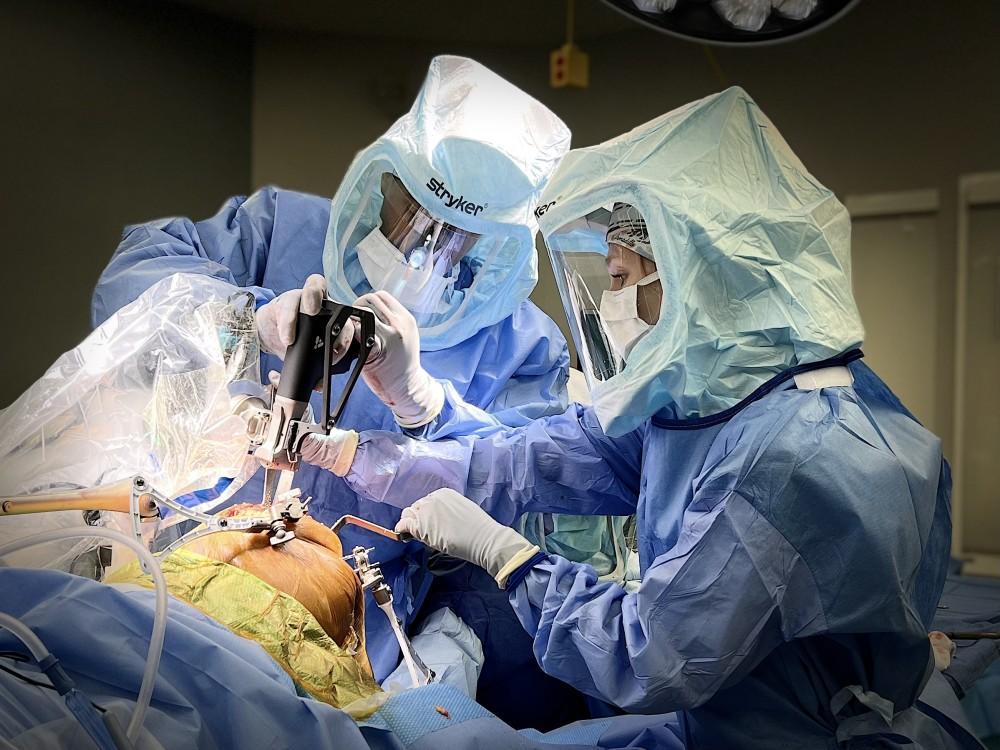
What are hip replacement implants made of?

Hip replacement surgery is a procedure where the degenerated bone and cartilage in your hip joint is exchanged for new implants. This article will outline exactly what implants are necessary and just what those implants are made of.
A standard total hip replacement consists of four individual components (see Figure 1 below):
Stem—inserts into the femur or thigh bone
Hip Cup—inserts into the hip socket of the pelvic bone
Ball—fits onto the end of the stem
Liner—inserts into the hip cup
The Stem
The femoral stem is the portion of the replacement that fits into your thigh bone. Historically, this is made from titanium and/or cobalt-chromium metals. In the modern era of hip replacements, cemented stems (inserted with a surgical bone cement) are composed of cobalt-chromium metals. Cementless stems (implants in which your bone grows into the metal) are routinely made of titanium. Both designs have had excellent long-term results as part of total hip replacement systems.
Both titanium and cobalt-chromium implants are considered highly biocompatible—meaning they are well tolerated by the human body with low risk of adverse reactions. In fact, both materials have been shown to be highly effective in being stable in the bone.
The top end of the femoral stem (called the trunnion) is specially shaped to hold the new ball of the artificial joint. Regardless of the material (ceramic or cobalt/chrome) that the ball is made out of, this is where the head and stem fit together.
The Hip Cup
The acetabular (cup) socket structure fits into your pelvis and is also made from various metals. The majority of modern cups are made from titanium or tantalum metals. Both metals are well tolerated by human bone and serve as excellent surfaces for attachment of the bone to the implant.
The metallic cups serve to hold the liner of the hip replacement, which essentially serves as a replacement for the hip socket cartilage. The liner is typically a plastic, highly cross-linked polyethylene, which is extremely durable. In some cases, instead of plastic liner, a metal liner is used and the ball portion of the hip is dual-mobility instead (see below).
In rare cases, the plastic liner may be used without a metallic cup and is held in place using a surgical bone cement.
The Ball (Femoral Head)
The femoral head (ball) fits on the top of the stem (trunnion). This end of the stem is taper shaped to allow the ball to wedge into position and be held tightly in place with friction. The ball comes in many different diameters often related to the size of the cup and liner that fits into the pelvis. The ball can be made from different materials:
Ceramic—Many refer to this as a porcelain type material. This is a very hard and durable surface and is extremely resistant to scratching or other damage. Ceramic heads can be paired with either ceramic or plastic liners.
Cobalt-chromium—For the better part of the last three decades, this has been the most common material used for the ball as it is relatively-scratch resistant and holds up well (similar to ceramic described above). Cobalt-chromium heads can be paired with plastic or metal liners. Due to some potential concerns for metal debris formation when cobalt-chromium heads are paired with metal liners recently brought to light, cobalt-chromium heads are now most commonly used with plastic liners instead of metal liners.
Dual-Mobility -This is a head within a head. In other words, either or a metal or ceramic inner ball is mated to the top of the femoral stem (trunnion). The outer ball is made of plastic (highly cross-linked polyethylene).
The Liner
The acetabular liner fits into the cup and serves as your new “cartilage”. Much like the cartilage in your hip, it is susceptible to wear and historically this has been the “weak link” of total hip replacement. Early forms of the liner were subject to wear by contacting the ball and were thought to last only about 10 years. However, some research suggests that these older liners actually lasted > 20 years. Modern day improvements to the liners have made them more durable, with the potential to last longer.
Ceramic—As mentioned above, ceramic is a very strong material and provides low wear rates when coupled with a ceramic ball (“ceramic-on-ceramic”).
Cobalt-chromium—Metal liners have fallen out of favor when used with metal balls over the last 10 years; however, newer options where a plastic ball is placed in a metal liner (known as dual mobility) have shown excellent short-term results in the United States and may be useful when utilized in specific patients.
Polyethylene—Plastic is by far the most common material used for hip replacement liners. This material has provided good to excellent results when paired with ceramic or cobalt-chromium balls. Recent advances in the manufacturing of polyethylene have significantly improved the wear rates of these plastic liners over the last 10-15 years.
Dr. Ugo Ihekweazu, is an orthopedic surgeon and an expert in Hip and Knee Replacement surgery in the Greater Houston Area. Dr. Ihekweazu is a member of the Fondren Orthopedic Group with offices in the Texas Medical Center and Willowbrook/Cypress. As one of the top young surgeons in the country, Dr. Ihekweazu has particular expertise in minimally invasive anterior and posterior total hip replacement surgery, hip resurfacing, partial knee replacement, minimally invasive total knee replacement surgery, computer navigation, robotic-assisted surgery, complex joint replacement and revision joint replacement surgery. If you have further questions about any of these surgical options please contact us today to make an appointment.
You Might Also Enjoy...


Robotic-Assisted Knee Replacement Surgery

100 Velys Robotic-Assisted Knee Replacement Surgeries

Texas Orthopedic Association Annual Meeting

DePuy Velys Robotic Assisted Knee Replacement Surgery



